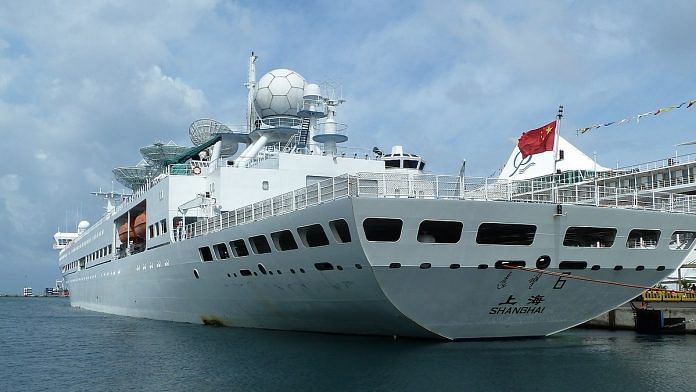New Delhi: The Chinese research vessel Yuan Wang 5 re-entered the Indian Ocean region earlier Monday, according to data collected by the Norwegian company Maritime Optima. At the time of filing this report, the Yuan Wang 5 is currently southbound in the Indian Ocean off the coast of the island of Java in Indonesia, Maritime Optima showed.
The development comes a week after India had issued a NOTAM (Notice to Airmen/Notice to Air Missions) about a missile test in the Andaman and Nicobar region, and a few days after the Yuan Wang 5 appeared to make a U-turn in response to India’s NOTAM.
Open source geospatial intelligence analyst Damien Symon had tweeted speculatively on 2 December, predicting the return of the Chinese vessel to the Indian Ocean region.
Speculative, but it appears like Yuan Wang 5, #China's satellite & missile tracking ship might be heading back to the #IndianOcean region pic.twitter.com/J81gTjFtNU
— Damien Symon (@detresfa_) December 2, 2022
The ongoing developments are far from the first time that a Yuan Wang-class ship, owned and operated by the Chinese PLA’s Strategic Support Force, has either changed course in response to an Indian-issued NOTAM or attracted the attention of the Indian Navy.
In November this year, the Yuan Wang 6 entered the Indian Ocean region ahead of a missile test slated for 11 November, for which India had issued a NOTAM, marking a significant area of the Bay of Bengal as a no-fly zone.
According to Symon, India had cancelled its previous NOTAM on 7 November owing to the presence of the Chinese vessel, and re-issued a NOTAM for the no-fly zone above the Bay of Bengal, with a launch window of 23-24 November.
As of 11/07/2022 0528 UTC #India's NOTAM for a suspected missile test has been cancelled, this is likely due to the presence of #China's Yuan Wang-class (satellite and ballistic missile tracking ship) in the #IndianOcean region
— Damien Symon (@detresfa_) November 7, 2022
#AreaWarning #India re-issues a notification for a no fly zone over the Bay of Bengal region indicative of an upcoming missile test, this while two of #China's missile & satellite tracking vessels now operate in the Indian Ocean region
Launch Window | 23 – 24 Nov 2022 pic.twitter.com/IsjrqjsVuf
— Damien Symon (@detresfa_) November 11, 2022
“The deployment is also in sync with a Chinese aerospace mission that flies over the Bay of Bengal between 15 and 20 November, which would put the Yuan Wang 6 near the Indian missile test’s splash zone as well,” Symon had contextualised about the vessel’s entry into the Indian Ocean at the time.
Earlier in August, the Yuan Wang 5 was slated to arrive on the 11th of that month at the Chinese-owned port of Hambantota in Sri Lanka. Following intervention by India, Colombo had briefly withdrawn berthing permission, delaying the vessel’s arrival at Hambantota.
However, the Yuan Wang 5 eventually docked at Hambantota on 16 August and departed Sri Lankan shores on 22 August.
The latest developments regarding the Yuan Wang 5’s movement, however, appear to be business as usual in the eyes of India’s Chief of Naval Staff, Admiral Hari Kumar, who said that plenty of Chinese ships operate in the Indian Ocean region and the Navy routinely monitors activity in the region to protect Indian interests in the region.
“We have a presence of 4-6 PLA Navy ships, then research vessels and a large number of fishing [vessels]. As resident maritime power [of the Indian Ocean Region], we keep monitoring and we are aware it is a vital region…We track them and make sure they don’t undertake any activities which are inimical to Indian interests,” Kumar told ThePrint.
Yuan Wang 5 was constructed in 2007 by Jiangnan Shipyard and though owned by the Chinese PLA, it is not operated by the PLA Navy. Instead, it is in use with the PLA’s Strategic Support Force, the fifth and newest branch of the Chinese PLA, established in December 2015.
The spy research vessel is among four active ships in the Yuan Wang-class responsible for tracking and supporting satellites as well as Intercontinental Ballistic Missiles (ICBMs).
The online news arm of Chinese company NetEase, referring to the role of the Yuan Wang-class under the newly formed Strategic Support Force, had reported in March 2016: “Yin Zhuo, a military expert, said in an interview with state media that the tasks of the Strategic Support Force include undertaking daily navigation operations, managing Beidou satellites (satellite navigation system) and space reconnaissance means, and undertaking defence tasks in electromagnetic space and cyberspace.”
(Edited by Amrtansh Arora)
Also Read: Indian Navy puts on hold plans to build IAC 2, but is considering repeat order of Vikrant






